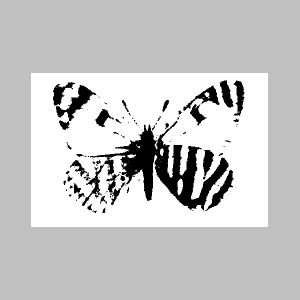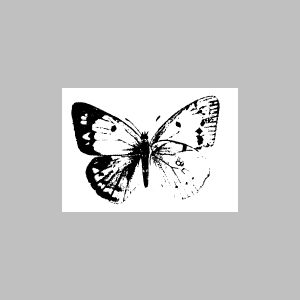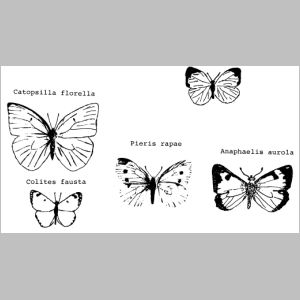Bulletin 15 - November 1981: Butterflies and Hawkmoths of Qatar and Eastern Saudi Arabia (Part 2)
Butterflies and Hawkmoths of Qatar and Eastern Saudi Arabia (Part 2)
A.R. PittawayPieridae
Pieris (= Artogeia rapae) (L) (Small White)
Saudi Arabia: Recorded as a winter and spring migrant as far south as Riyadh.
Euchloe belemia Esper (Green Striped White)
General range: from N.W. Africa and S.W. Europe across N. Africa, Saudi Arabia to Mesopotamia and Iran.
Saudi Arabia: Found in the bush and grass strewn coastal sand dunes as well as the Rhanterium and camel-grass steppe areas on the eastern coast from Abu Hadriyah to Al Mish’ab. Small numbers also occur in the Tarut Island and Quatif Oasis.
Adults: 38-46 mm. On the wing from mid January to mid March in two or three broods. It is a fast, strong, zig-zagging flyer staying close to the ground, often following definable courses repeatedly. It is greatly attracted to earth ridges that support larger than normal Cruciferae. In very strong winds most will seek shelter on the ground behind a grass tussock.
Early stages: the seed pods of tall annual Cruciferae such as Sinapsis, Brassica, and Sisymbrium are the commonest food plants. In the Quatif Oasis the isolated population exist solely on the pods of cultivated root Brassica. The young larvae are bluish-green with a profusion of black bristles and are very thin. They rest along the narrow seed pods of the food plant when not consuming them with as many as five larvae per plant being common.
The pupae: 20-30 mm and similar to the European Orange Tip (Anthocharis cardamines) (L) but are more cylindrical and brownish-grey. They are formed away from the food plant usually amongst Rhanterium. Local range – coastal areas including the U.A.E.
Flight time: January – March (2/3 broods)
Food plant: Seed heads of Sinapsis and Brassica
Euchloe falloui Allard (Scarce Green Striped White)
General range: N. Africa across to Sudan and Central Arabia where it is found in small, isolated colonies along the Tuwayq Hills, frequenting open, flat salt-free, rocky desert steppe especially mini-plateaus separated by wadis.
Adult: 36 – 38 mm. Very similar in behaviour to Euchloe belemia but not such a fast flyer. As many of each species resemble each other, genitalia comparisons should be undertaken.
Flight time: March (one brood)
Food plant: Moricandia sinaica
Pontia glauconome Klug (Desert White)
General range: From Somalia north to Libya and east to Arabia and Iran.
Saudi Arabia: In E. Saudi Arabia this species is found almost anywhere where rocky outcrops occur – rocky plains and hills to the north, west and south of Riyadh. Also around Dhahran, Khobar and Al Hassa Oasis. It favours rocky wadis and surrounding gullies, also sandy areas with perennial Cruciferae (Zilla).
Adult: 43 – 46 mm. A very fast, zig-zagging low flying species often settling on Cruciferae flowers bordering abandoned date plantations.
Common from early March to early December in a multitude of overlapping broods which differ from area to area depending on the rains. In certain favourable localities e.g. Tuwayq Hills or Wadis it often abounds in May and October. Maturing larva or pupa over-winter on the food plant.
Early stages: Although usually found on the shrubby Ochradenus species (Resedaceae), the larvae also feed on Reseda, Zilla, Diplotaxis harra, Moricandia sinaica, (the latter only around Riyadh during Spring). The larvae take leaves, flowers and seed pods with equal relish.
The pale creamy white, conical, ribbed eggs are laid singly either on the flower stalks (Zilla) or leaf surface (Ochradenus).
The full grown larvae (30 – 40 mm) which are very similar to those of Pontia daplidice L. feed openly with as many as 5 – 6 individuals per plant.
The pupae: (16 – 20 mm) Very similar to those of P. daplidice and are formed head downwards at the base of a shoot, usually on the main shoot at the approach of winter. The brood of the summer pupae are of a china-white in colour and are found almost anywhere on the plant.
In Qatar: They are locally found in Doha, Al Samriyah 23 km north of Doha, Al Sunu, Rawdat al Faras and Al Jumailiyah.
Particularly attracted to Pulicaria flowers. It is variable especially with regard to the amount of ‘green’ pigmentation on the underside. At times this is very heavy but at others it is almost absent.
During April – June 1979 it brooded continuously with no synchronisation of emergence between areas, although in any one locality all adults emerged within a few days of each other.
Early stages: The larvae are black tubercled, and grey and white longitudinally banded. They were very numerous in all stages of development on Ochradimus although some were also found on Roseda.
Most of the pupae present on the food plant were china-white with a few orange-black markings. These occurred on fully exposed stalks. Others resembled the larvae i.e. pale grey, darker on the wing-cases, thorax and head. These were found on the not so exposed locations. The thorax crest, abdominal spines and head-thorn is black with reddish brown streaks. The dorsal surface of the abdomen has dark and light grey longitudinal bands. All pupae were covered with fine black spots.
Colias croceus
(Geoffrey) (Clouded Yellow)
General range: Across Southern and Central Europe to N. Africa, Iran and the Arabian Peninsula.
Saudi Arabia: Common at Tuwayq Hills. Abundant in all major cultivated eastern oases – Al Hassa, Quatif, Tarut Island and Safway, favouring Medicago sativa fields.
Small isolated populations also exist around Manifa, north of Jubail, on beds of annual winter legumes growing in the hollows between coastal sand dunes. These populations are also supplemented by migrants.
Adult: 48 – 54 mm. Occurs from December to early May but at Manifa during February and March.
It has a characteristic to and fro flight over low vegetation where it frequently settles on sweet basil (Ocimum basilicum) flowers in oases.
Early stages: The food plants are Medicago sativa, Sesbania and various annual trefoils and vetches. The larvae and pupae are identical to European examples.
Qatar: Here it was only found flying over the Lucerne fields of one of Wukair’s gardens in quite large numbers during early June. It is possible it also frequented numerous other enclosed, cultivated areas.
Anaphaeis aurota Fabricius (Brown-veined White)
General range: From sub-Saharan Africa across Arabia to Syria, India and Sri Lanka.
Saudi Arabia: A small isolated population exists on Tarut Island. After a large bread it re-appears in the east Tuwayq Hills, from Al Kharj to Buraydah, frequenting abandoned date plantations in oases or wadis. It is especially common in Wadi Hanifa to the west of Eiyadh. Whilst it may occur over a large area it favours large, definite colonies where numbers wax and wane due to heavy predation.
Adult: 53 – 58 mm. A powerful flyer seen dashing between date palms, across clearings and over the ground where it frequently settles, often stopping to sip the nectar from flowers. It has been observed from mid November to mid April with three peaks: late November, mid to late January and late March.
Early stages: The food plants are the Capparis species but only those in or near oases. The pale yellow conical, heavily ribbed eggs are laid in groups of up to 30 on the leaf underside of growing shoots with sometimes more than 4 batches per shoot. After a few days they turn orange and then, prior to emergence, grey. The larvae are greyish green when young and covered in dark bristles, they are very gregarious.
When fully grown (35 mm) they are mid-grey with a broad greenish-yellow dorsal band and a yellowish underside. Two very distinct features are the long pale, ventral hairs and small orange spots covering the whole body. Once they reach this size and colour they are very inactive – spending much of their time sunbathing.
The pupae are approximately 17 mm long, resembling Pieris brassicae (L.) but basically grey, or green with dark markings and a greenish dorsal band. The orange spots are very conspicuous even more so than on the larvae. The pupae are normally formed at the base of a shoot.
In Qatar: They only occurred as a breeding species across the northern Central Region (40 – 50 km north of Doha), frequenting Capparis in an overgrown ‘Zizyphus depression’. As a migrant it was encountered all over the country throughout the period April – June.
By chance, the build-up to a migration was witnessed. Fifty-three km to the north of Doha was a ‘Zizyphus depression’, about the size of a football pitch, where all open ground was covered by Capparis spinosa. On the 4th May, adults were already common here and virtually every Caper shrup was covered with larvae and ova of this species. Two plants alone had over 100 larvae each. By the 17th May, butterflies were super-abundant, although not very active. Each Zizyphus bush was draped with up to 1000 individuals, which only took flight on being disturbed. No feeding activity was witnessed, nor any normal flight patterns. Nearly every nearby Caper plant had been completely stripped of foliage and the resulting bare branches carried masses of pupae and starving larvae.
It was estimated that for every adult butterfly there were at least 10 pupae waiting to emerge.
Over the following week, adults were seen passing through Al Sunu and Doha towards the west and south. By the 25th May, the ‘Zizyphus depression’ was virtually devoid of butterflies, and of the pupae seen previously only about half had emerged, the rest succumbing to a virulent bacteriological disease. A. aurota was still observed passing through Doha on the 6th June, but at the ‘depression’ this species appeared to have become extinct.
This same phenomenon also occurred at three other neighbouring sites, but at a fourth no population explosion took place and the butterfly did not die out.
Early stages: In Qatar the pupae which were fully exposed on a stem tended to be china-white with a number of grey streaks on the wing cases, besides being covered in pale orange spots.
Colotis fausta Olivier (Large Salmon Arab)
General range: From Egypt through Arabia, Iraq, southern Iran to India and Sri Lanka.
Saudi Arabia: Found in the same areas as A. aurota i.e. Tarut Island and Tuwayq Hills. Common to the west of Riyadh in Wadi Hanifa.
Occurs as ssp. fausta, closely resembling specimens from Mesopotamia and also found in similar habitats – edges of cultivated fields or abandoned date plantations where Capparis has colonised.
Adult: 48 – 50 mm. Very fast flyer and solitary, dashing very close to the ground, on which it frequently settles with wings closed. Dorsally it resembles a pinkish-orange Colias croceus Geoffrey.
It was observed in Wadi Hanifa from mid November to mid May. On Tarut Island seen in very limited numbers only during January and February.
Early stages: Feeds on Capparis, especially spinosa.
Qatar: A solitary species, normally roosting alone but when large numbers of A. aurota were present, it passed the night in the company of these, hanging amongst twigs of Z. nummularia.
Catopsilia florella Fabricius
General range: From the Canary Islands across sub-Saharan Africa, through Egypt and Arabia to India and China.
Saudi Arabia: Only found in the Tuwayq Hills west and north of Riyadh, frequenting wadis with abandoned date plantations and sand bars.
Adult: 65 – 75 mm. A very fast and direct flyer, most often seen dashing along the edges of plantations. It is, however, rare and may only be a migrant in this area, occurring in April, although in Western Saudi Arabia (Jeddah) it flies from March to July.
Early stages: Cassia italica, a small shrub found in wadis, is the only food plant in the eastern region.
The eggs, which are almost identical to those of Colias croceus Geoffrey, are laid on the upper and lower surfaces of the plant leaves.
Fully grown larvae (40 – 45 mm) are dorsally leaf green with cross-lines of fine, dark, bristle bearing tubercles. A double lateral line of black and yellow is present. Head leaf green with fine, black spots. This colour scheme provides good camouflage amongst the flower heads and leaves where the larvae rest.
Eureme hecabe Boisduval
General range: Right across sub-Saharan Africa and tropical Asia to Japan in numerous subspecies.
Saudi Arabia: In eastern Saudi Arabia it was confined to the oases around Quatif and on Tarut Island as ssp. senegalensis Bdv., frequenting the edges of cultivated fields, especially those of Lucerne. However, in Quatif Oasis, where it is less common, individuals are often seen flying between date palms on overgrown, abandoned plots.
Adult: 40 – 44 mm. A weak flyer, staying close to the ground where it often settles amongst Lucerne. It is an avid visitor of nectar rich flowers, especially sweet basil, from which it feeds for lengthy periods.
The generations are identical in appearance, the species flying from December to mid May with two peaks: one during January and the other in late March.
Early stages: The sole food plant of this species is Sesbania sesban, and introduced, small, upright tree similar to Laburnum in many respects, especially the flowers, but not the pinnate leaves.
Small isolated saplings situated in sunlight dappled clearings, or field borders, are selected on which to lay the yellow, conical and heavily ribbed single eggs, which turn orange prior to hatching.
The fully grown larvae (30 – 33 mm) are very similar to those of Colias croceus Geoffrey (which can also be found on the same plant), but are thin, cylindrical and lack any trace of red along the yellow lateral line. Otherwise they are dark green including the head, and covered in fine, black bristles.
Most rest along a leaf midrib, on the upper side, where they are very well camouflaged.
The pupa (15 mm) is again very similar to that of C. croceus, but more finely proportioned and pale green. Usually formed under a leaf if hatching soon; otherwise at the tree base.



